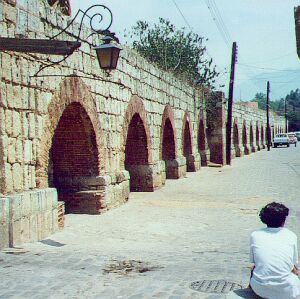Home >>
Oaxaca >>
Oaxaca, Oaxaca >>
An Expatriate Life >>
Letters >>
The Hidden Places
Royal palms, reaching 60 feet into the clear blue sky, testify to the age of this place. Limes grow here, as do pecans and pomegranates, and the ever-present bougainvillea. Wild flowers come and go in season: clumps of pale yellow, orange-red and powder blue. During the long dry season, the occasional wind stirs the dusty soil. Water is precious, and the people who live here think it wrong that others waste it maintaining thirsty grasses and cultivated flowers. Birds abound: common migratory species such as chickadees and sparrows nest in the trees and the eaves of buildings, and cockatiels, parakeets, and a full-sized parrot inhabit cages near the houses.
Four dwellings are haphazardly arranged in this compound. The largest has perhaps four or five rooms which are enlargements and extensions of the original cement cube. There is a newer-looking structure of two rooms. There are two one-room shacks with front porches. Pieces of tin and rough timbers are all that are left of a lean-to hanging off the end of one of the shacks: a casualty of the big hailstorm two years ago.
There is no indoor plumbing. Communal toilets and a shower stall stand in one corner of the property. There is a forge in another corner where the owner's cousin does iron-working. He lives in the two-room house. The one-room places are rented to recent arrivals from the mountains.

This is the old aqueduct that used to bring water down to Oaxaca city from (then) far away San Felipe del Agua, now a suburb. When the city changed to underground pipes, people built homes behind it. Entry is through the arches. Thus, this neighborhood is known as "Los Arcos". All the entrances look pretty much alike, but what is inside could be anything from a primitive dirt compound to House Beautiful.
[Photo by Diana Ricci]
|
A late-model Nissan auto is parked next to the big house. A 1959 Ford sedan, perfectly preserved and minus the rear axle, sits, as it has for 8 years now, on cement blocks near the outhouses. There are toys, tricycles, and other childrens' paraphernalia scattered about.
The compound is surrounded by walls of two and three stories. They are the back walls of the warehouses, restaurants, rooming houses and industrial properties that form the boundaries of this ancient rural-seeming property, located in the largest and most populous city between Mexico City / Puebla and Guatemala.
Blocks in Oaxaca are larger than are their U.S. counterparts. Often, as in this case, the street-facing properties do not go all the way to mid-block. To reach this particular property, you enter a long, narrow passage between a plumbing warehouse and a small shop that sells roasted chickens. Behind the shop, along the passageway, a door provides access to a working-class rooming house. Past the rooming house, at the end of the passageway, is the front (pedestrian) entrance to the compound. On the back side of the compound, there is an auto entrance. It is reached through the back of a public parking lot facing the next street over. When the lot is crowded, it can get tricky using the car. Cooperation and courtesy are required, and supplied, on both sides of the wall.
Julio is a doctor, and his wife is a civil servant. Julio was born in the big house, before the extra rooms were added. He does not know exactly how long his family has lived here, although he believes that his mother's grandparents did not live here when his mother's mother was born. "Inside places" are often unregistered. Ownership is established by occupation. Registration can be a complex procedure, often requiring the separate agreements of several neighbors.
Inside places may or may not reflect the status of the buildings surrounding them. Friends of mine live in a small apartment house with a swimming pool and satellite TV. They pay their rent in US dollars. Their block contains a pleasant mid-priced restaurant, several medical and dental offices, an interior decorator's shop, and one of the most squalid Inside places you could imagine, a jumble of cardboard, tar-paper, tin, and plastic tarpaulins, with outdoor cooking fires, a lean-to in front of a slit trench for sanitation, the rusted skeletons of washing machines, refrigerators, and what may have been a Hudson Hornet automobile. The people who live here are "squatters", come from elsewhere, to look for work; crazies; fugitives; people dispossessed: of land, money, their wits, their self-control. I am told that there are a great many such Inside places in Oaxaca.
Last week I visited an Inside place with beautiful patios, well-tended gardens and all the modern conveniences -- set inside a block of junkyards and iron mongers' workshops.
There is a diverse and rich social mix in Oaxaca, and it may not be apparent to the casual observer. Modesty is considered a virtue, and many of those who are well-off don't like to advertise it. They drive nondescript sedans, and live behind tall walls which conceal them from their neighbors. It's not that their neighbors don't know, but rather that they don't get their noses rubbed in it. One family I know, living in a marginal, semi-commercial neighborhood, behind a blank wall with a simple door, have a private garden complete with swimming pool and wet bar. Their house is three stories, very modern in design, and centrally air conditioned.
Much is hidden, and without taking the time, learning the language, and keeping your eyes and ears open, you just don't get it. You're not supposed to. But once you do, you begin to see the hidden places as another metaphor for life in a country in which many things turn out to be different than you first thought they were.
(August 1995)
| Top of page |
